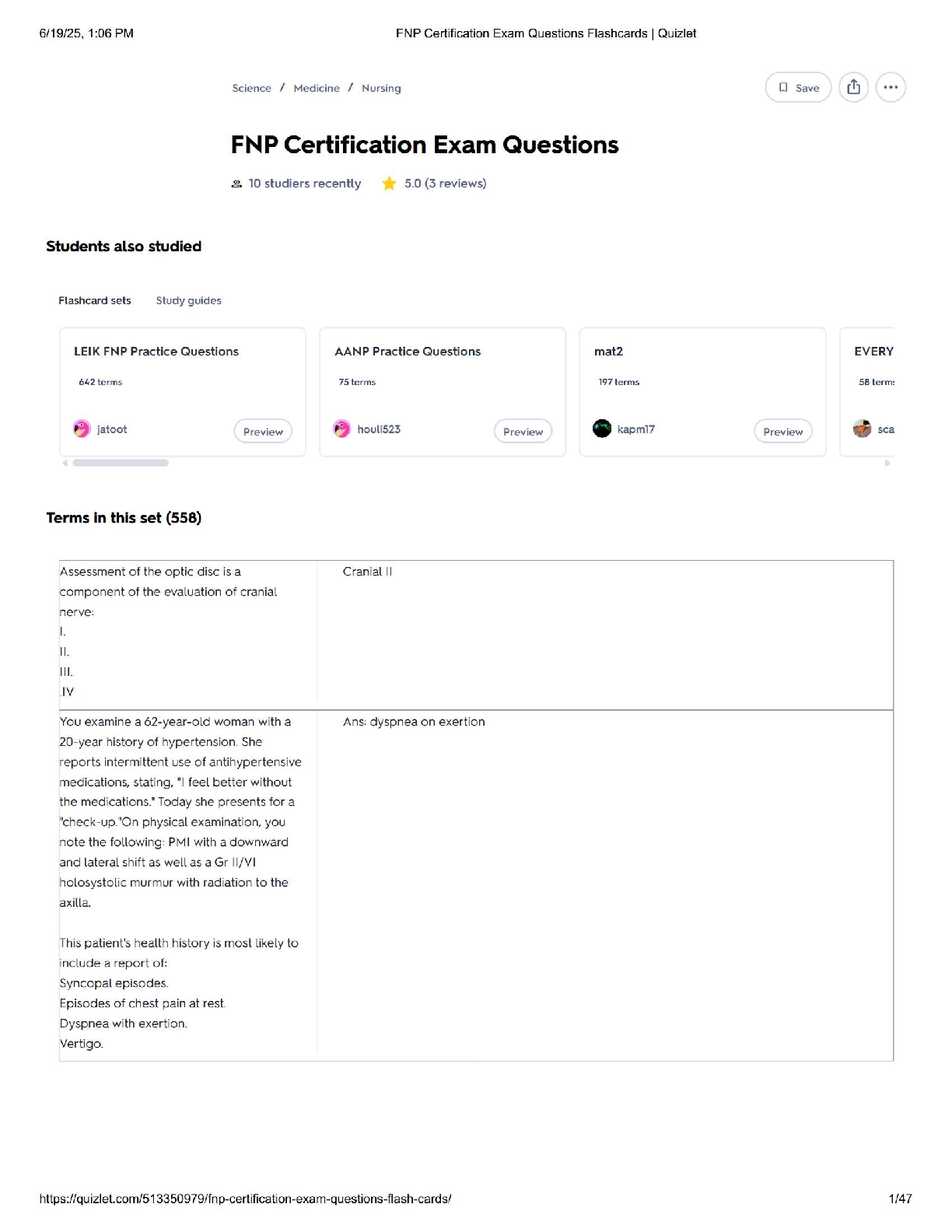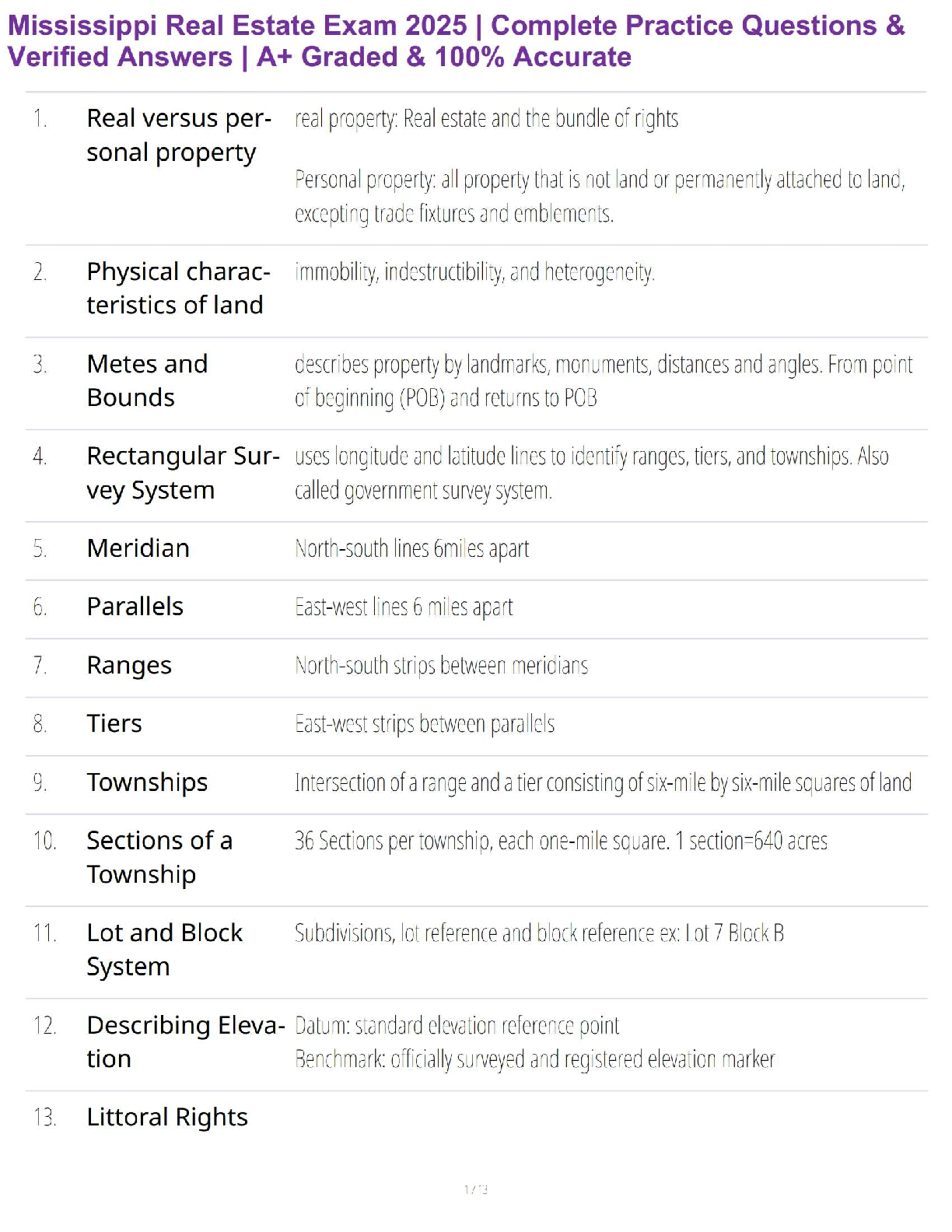*NURSING > EXAM > NURSING 210 complete practice questions and answers 2020\2021 ..frequentry asked questions Graded A+ (All)
NURSING 210 complete practice questions and answers 2020\2021 ..frequentry asked questions Graded A+
Document Content and Description Below
NURSING 210 complete practice questions and answers 2020\2021 Unit 1 Practice Questions Multiple Choice Identify the choice that best completes the statement or answers the question. ____ 1. ... Which drug will go through a disintegration process after it is administered? a. Intramuscular (IM) cephalosporins b. Intravenous (IV) vasopressors c. Oral analgesics d. Subcutaneous antiglycemics ____ 2. The nurse is preparing to administer an oral medication and wants to ensure a rapid drug action. Which form of the medication will the nurse administer? a. Capsule b. Enteric-coated pill c. Liquid suspension d. Tablet ____ 3. The nurse is teaching a patient who will be discharged home with a prescription for an enteric-coated tablet. Which statement by the patient indicates understanding of the teaching? a. “I may crush the tablet and put it in applesauce to improve absorption.” b. “I should consume acidic foods to enhance absorption of this medication.” c. “I should expect a delay in onset of the drug’s effects after taking the tablet.” d. “I should take this medication with high-fat foods to improve its action.” ____ 4. A patient who is newly diagnosed with type 1 diabetes mellitus asks why insulin must be given by subcutaneous injection instead of by mouth. The nurse will explain that this is because a. absorption is diminished by the first-pass effects in the liver. b. absorption is faster when insulin is given subcutaneously. c. digestive enzymes in the GI tract prevent absorption. d. the oral form is less predictable with more adverse effects. ____ 5. The nurse is preparing to administer an oral medication that is water soluble. The nurse understands that this drug a. must be taken on an empty stomach. b. requires active transport for absorption. c. should be taken with fatty foods. d. will readily diffuse into the GI tract. ____ 6. A nurse is preparing to administer an oral drug that is best absorbed in an acidic environment. How will the nurse give the drug? a. On an empty stomach b. With a full glass of water c. With food d. With high-fat food ____ 7. The nurse is preparing an injectable drug and wants to administer it for rapid absorption. How will the nurse give this medication? a. IM into the deltoid muscle b. IM into the gluteal muscle c. Subcut into abdominal tissue d. Subcut into the upper arm ____ 8. The nurse is reviewing medication information with a nursing student prior to administering an oral drug and notes that the drug has extensive first-pass effects. Which statement by the student indicates a need for further teaching about this medication? a. “The first-pass effect means the drug may be absorbed into systemic circulation from the intestinal lumen.” b. “The first-pass effect means the drug may be changed to an inactive form and excreted.” c. “The first-pass effect means the drug may be changed to a metabolite, which may be more active than the original.” d. “The first-pass effect means the drug may be unchanged as it passes through the liver.” ____ 9. The nurse prepares to change a patient’s medication from an IV to an oral form and notes that the oral form is ordered in a higher dose. The nurse understands that this is due to differences in a. bioavailability. b. pinocytosis. c. protein binding. d. tachyphylaxis. ____ 10. The nurse is preparing to administer a drug and learns that it binds to protein at a rate of 90%. The patient’s serum albumin level is low. The nurse will observe the patient for a. decreased drug absorption. b. decreased drug interactions. c. decreased drug toxicity. d. increased drug effects. ____ 11. The nurse is administering two drugs to a patient and learns that both drugs are highly protein-bound. The nurse may expect a. decreased bioavailability of both drugs. b. decreased drug effects. c. decreased drug interactions. d. increased risk of adverse effects. ____ 12. A patient has been taking a drug that has a protein-binding effect of 75%. The provider adds a new medication that has a protein-binding effect of 90%. The nurse will expect a. decreased drug effects of the first drug. b. decreased therapeutic range of the first drug. c. increased drug effects of the first drug. d. increased therapeutic range of the first drug. ____ 13. The nurse gives a medication to a patient with a history of liver disease. The nurse will monitor this patient for a. decreased drug effects. b. increased drug effects. c. decreased therapeutic range. d. increased therapeutic range. ____ 14. The nurse gives 800 mg of a drug that has a half-life of 8 hours. How much drug will be left in the body in 24 hours if no additional drug is given? a. None b. 50 mg c. 100 mg d. 200 mg ____ 15. If a drug has a half-life of 12 hours and is given twice daily starting at 0800 on a Monday, when will a steady state be achieved? a. 0800 on Tuesday b. 0800 on Wednesday c. 0800 on Thursday d. 0800 on Friday ____ 16. The nurse is preparing to administer a drug that is ordered to be given twice daily. The nurse reviews the medication information and learns that the drug has a half-life of 24 hours. What will the nurse do next? a. Administer the medication as ordered b. Contact the provider to discuss daily dosing c. Discuss every-other-day dosing with the provider d. Hold the medication ____ 17. The nurse is caring for a patient who has taken an overdose of aspirin several hours prior. The provider orders sodium bicarbonate to be given. The nurse understands that this drug is given for which purpose? a. To counter the toxic effects of the aspirin b. To decrease the half-life of the aspirin c. To increase the excretion of the aspirin d. To neutralize the acid of the aspirin ____ 18. The nurse is preparing to administer a drug that is eliminated through the kidneys. The nurse reviews the patient’s chart and notes that the patient has increased serum creatinine and blood urea nitrogen (BUN). The nurse will perform which action? a. Administer the drug as ordered. b. Anticipate a shorter than usual half-life of the drug. c. Expect decreased drug effects when the drug is given. d. Notify the provider and discuss giving a lower dose. ____ 19. The nurse understands that the length of time needed for a drug to reach the minimum effective concentration (MEC) is the a. duration of action. b. onset of action. c. peak action time. d. time response curve. ____ 20. The nurse administers albuterol to a patient who has asthma. The albuterol acts by stimulating beta2-adrenergic receptors to cause bronchodilation. The nurse understands that albuterol is a beta-adrenergic a. agonist. b. antagonist. c. inhibitor. d. depressant. ____ 21. The nurse is explaining to the patient why a nonspecific drug has so many side effects. Which statement by the patient indicates a need for further teaching? a. “Non-specific drugs can affect specific receptor types in different body tissues.” b. “Non-specific drugs can affect a variety of receptor types in similar body tissues.” c. “Non-specific drugs can affect hormone secretion as well as cellular functions.” d. “Non-specific drugs require higher doses than specific drugs to be effective.” ____ 22. The nurse is preparing to administer the first dose of digoxin (Lanoxin) to a patient and notes that the dose ordered is much higher than the usual recommended dose. Which action will the nurse perform? a. Administer the dose as ordered. b. Give the dose and monitor for toxicity. c. Hold the dose until reviewing it with the provider. d. Refuse to give the dose. ____ 23. The nurse administers a narcotic analgesic to a patient who has been receiving it for 1 day after orthopedic surgery. The patient reports no change in pain 30 minutes after the medication is given. The nurse recognizes that this patient is exhibiting a. drug-seeking behavior. b. drug tolerance. c. the placebo effect. d. tachyphylaxis. ____ 24. A patient has been taking a drug for several years and tells the nurse it is no longer working. The nurse learns that the patient has recently begun taking an over-the-counter (OTC) antacid medication. What does the nurse suspect is occurring? a. An adverse drug reaction b. A drug interaction c. Drug incompatibility d. Drug tolerance ____ 25. The nurse is preparing to administer two IV medications that should not be given using the same IV tubing. The nurse understands that this is because of drug a. adverse reactions. b. incompatibility. c. interactions. d. potentiation. ____ 26. The nurse is teaching a patient who will begin taking ciprofloxacin. What instruction will the nurse include when teaching this patient about this drug? a. “Do not take this medication with oral contraceptive pills.” b. “Take at least 1 hour after or 2 hours before taking antacids.” c. “Take in the morning with your multivitamin tablet.” d. “Take with milk to reduce gastric upset.” ____ 27. A patient who takes a drug that undergoes gastric absorption will begin taking an opioid analgesic after sustaining an injury in a motor vehicle accident. The nurse will observe the patient closely for which effects? a. Decreased effects of the first drug b. Increased effects of the first drug c. Decreased effects of the narcotic d. Increased effects of the narcotic ____ 28. The nurse is preparing to administer furosemide to a patient who takes digoxin. The nurse will plan to monitor the patient for a. digoxin toxicity. b. decreased digoxin effects. c. erythromycin toxicity. d. decreased erythromycin effects. ____ 29. A young adult female patient who takes a combination oral contraceptive (OCP) will begin taking an antibiotic. When teaching the patient about this medication, the nurse will a. recommend using a backup method of contraception. b. suggest that she switch to an injectable form of contraception. c. tell her that the antibiotic is less effective if she is taking OCPs. d. tell her the antibiotic has a greater risk for toxicity while taking OCPs. ____ 30. A patient has been taking warfarin (Coumadin), which is highly protein-bound. The patient will begin taking gemfibrozil, which is also highly protein-bound. The nurse will observe the patient closely for a. decreased effects of warfarin. b. increased effects of warfarin. c. decreased effects of gemfibrozil. d. decreased effects of both drugs. ____ 31. A patient is taking phenytoin to prevent seizures. The nurse knows that phenytoin is highly protein-bound and has sedative’s side effects. The nurse reviews the patient’s chart and notes a low serum albumin. The nurse will notify the provider and observe the patient for which effects? a. Decreased sedative effects b. Increased sedative effects c. Increased seizures d. No change in effects ____ 32. A patient who takes the anticoagulant warfarin will begin taking the anticonvulsant drug carbamazepine. The nurse reviews the drug information for these drugs and learns that carbamazepine is a hepatic enzyme inducer. The nurse anticipates that the provider will make which dosage adjustment? a. Decrease the dose of carbamazepine b. Increase the dose of carbamazepine c. Decrease the dose of warfarin d. Increase the dose of warfarin ____ 33. The nurse is caring for a patient who receives theophylline, which has a narrow therapeutic index. The patient has been receiving cimetidine but will stop taking that drug in 2 days. In 2 days, the nurse will observe the patient closely for a. decreased effectiveness of theophylline. b. increased effectiveness of theophylline. c. decreased toxicity of theophylline. d. prolonged effectiveness of theophylline. ____ 34. The nurse is caring for a patient who takes digoxin to treat heart failure. The provider orders furosemide to treat edema. The nurse will monitor the patient for digitalis toxicity because of a. adverse drug reactions caused by giving these drugs in combination. b. altered hepatic blood flow caused by the furosemide. c. changes in reabsorption of water and electrolytes in the kidneys. d. additive effects of these two drugs given together. ____ 35. A patient will receive penicillin to treat an infection. The provider orders probenecid (Probalan), a medication to treat gout, even though the patient does not have gout. Which action by the nurse is correct? a. Administer the drug since the provider ordered it. b. Recognize that it is being given prophylactically. c. Refuse to administer the medication since it is not indicated. d. Verify that it is being given for its secondary action. ____ 36. The nurse is preparing to administer meperidine (Demerol), which is an opioid analgesic, and promethazine (Phenergan), which is an antiemetic and antihistamine. The nurse understands that these drugs are given in combination for which reason? a. They have antagonistic effects to reduce nausea. b. They have additive effects to enhance analgesia. c. They have potentiating effects to decrease an allergic response. d. They have synergistic effects to increase sedation. ____ 37. The provider has ordered amoxicillin with clavulanate (Augmentin) for a child who has otitis media. The child’s parent asks why this drug is necessary when amoxicillin is less expensive. The nurse will explain that clavulanate is added to amoxicillin because it a. binds with albumin to increase the amount of available amoxicillin. b. broadens the spectrum of amoxicillin by inhibiting bacterial enzymes. c. inhibits hepatic blood flow, leading to increased serum drug levels of amoxicillin. d. inhibits the excretion of amoxicillin by interfering with renal function. ____ 38. The nurse assesses a patient who is receiving morphine sulfate intravenously using a patient-controlled analgesia pump. The nurse notes somnolence and respiratory depression, which are signs of morphine toxicity. The nurse will prepare to administer naloxone (Narcan) because it a. has synergistic effects with morphine. b. is a narcotic agonist. c. is a narcotic antagonist. d. potentiates narcotic effects. ____ 39. The nurse is teaching a patient about a drug that causes photosensitivity. Which statement by the patient indicates a need for further teaching? a. “I should apply sunscreen with a sun protection factor greater than 15.” b. “I should avoid sunlight when possible while taking this drug.” c. “I will wear protective clothing when I am outdoors.” d. “I will wear sunglasses even while I am indoors.” ____ 40. A patient asks the nurse about using OTC medications. The nurse will tell the patient that OTC medications a. are not as effective as prescription medications. b. are not as safe as prescription medications. c. have fewer side effects and drug interactions than prescription medications. d. should be included when listing any medications taken by the patient. ____ 41. The nurse is educating the parent of a 20-month-old toddler about OTC products to treat cold symptoms. Which statement by the parent indicates understanding of the teaching? a. “I should check with the provider for proper dosing instructions.” b. “OTC medications are less potent and have minimal side effects.” c. “OTC medications can be given to children younger than 2 years old.” d. “Using OTC medications may prevent accurate diagnosis of respiratory illness.” ____ 42. A patient calls the clinic and tells the nurse that a newly prescribed medication isn’t working. What is the nurse’s next action? a. Notify the provider and discuss increasing the dose. b. Question the patient about compliance with the regimen. c. Review the drug information with the patient. d. Suggest the patient discuss changing medications with the provider. ____ 43. The community health nurse is teaching a group of elderly residents in an assisted care facility about medication use. The nurse will remind the residents that OTC medications a. are not as effective as prescription medications. b. are not recommended for older adults. c. are safer than prescription medications. d. should be reviewed with a provider before taking. ____ 44. The nurse is preparing to teach a patient who will begin taking a monoamine oxidase (MAO) inhibitor. What is most important when teaching patients about MAO inhibitors? a. Emphasizing the importance of potassium intake b. Giving detailed drug information c. Reviewing dietary guidelines d. Providing a schedule for medication administration ____ 45. The nurse is teaching a patient about taking a once-daily medication that has a side effect of drowsiness. The nurse learns that the patient works a 7:00 PM to 7:00 AM shift in a hospital. The nurse will recommend that the patient take this medication at which time of day? a. 0600 b. 0800 c. 1800 d. 2000 ____ 46. The nurse is caring for an older adult patient who is receiving multiple medications. When monitoring this patient for potential drug toxicity, the nurse should review which lab values closely? a. Complete blood count and serum glucose levels b. Pancreatic enzymes and urinalysis c. Serum creatinine and liver function tests (LFTs) d. Serum lipids and electrolytes ____ 47. An older patient who reports a 2- to 3-year history of upper gastrointestinal (GI) symptoms will begin taking ranitidine (Zantac) to treat this disorder. The patient has completed a health history form. The nurse notes that the patient answered “no” when asked if any medications were being taken. Which action will the nurse take next? a. Ask whether the patient uses over-the-counter (OTC) medications. b. Obtain a careful dietary history for the past two weeks. c. Recommend that the patient take antacid tablets. d. Suggest that the patient add high-potassium foods to the diet. ____ 48. To assist an older, confused patient to adhere to a multidrug regimen, the nurse will provide which recommendation? a. Avoid the use of OTC medications. b. Bring all medications to each clinic visit. c. Review the manufacturer’s information insert about each medication. d. Save money by getting each drug at the pharmacy with the lowest price. ____ 49. The nurse is caring for an older patient who is taking 25 mg per day of hydrochlorothiazide. The nurse will closely monitor which lab value in this patient? a. Coagulation studies b. White blood count c. LFTs d. Serum potassium ____ 50. The nurse is caring for an 82-year-old patient who takes digoxin to treat chronic atrial fibrillation. When caring for this patient, to monitor for drug side effects, what will the nurse carefully assess? a. Blood pressure b. Heart rate c. Oxygen saturation d. Respiratory rate ____ 51. The nurse is caring for an 80-year-old patient who is taking warfarin (Coumadin). Which action does the nurse understand is important when caring for this patient? a. Encouraging the patient to rise slowly from a sitting position b. Initiating a fall-risk protocol c. Maintaining strict intake and output measures d. Monitoring blood pressure frequently ____ 52. An 80-year-old patient is being treated for an infection. An order for which type of antibiotic would cause concern for the nurse caring for this patient? a. Aminoglycoside b. Cephalosporin c. Penicillin d. Sulfonamide ____ 53. A 75-year-old patient will be discharged home with a prescription for an opioid analgesic. To help the patient minimize adverse effects, what will the nurse recommend for this patient? a. Sucking on lozenges to moisten oral mucosa b. Taking an antacid with each dose c. Taking the medication on an empty stomach d. Using a stool softener ____ 54. A 75-year-old patient is readmitted to the hospital to treat recurrent pneumonia. The patient had been discharged home with a prescription for antibiotics 5 days prior. The nurse admitting this patient will take which initial action? a. Ask the patient about OTC drug use. b. Ask the patient how many doses of the antibiotic have been taken. c. Discuss increasing the antibiotic dose with the provider. d. Obtain an order for a creatinine clearance test. ____ 55. The nurse is performing an admission assessment on an 80-year-old patient who has frequent hospital admissions. The patient appears more disoriented and confused than usual. Which action by the nurse is correct? a. Asking about medication doses b. Asking for a neurologist consult c. Requesting orders for LFTs d. Suspecting impaired renal function ____ 56. An older patient takes ibuprofen for arthritis pain. The patient tells the nurse that the ibuprofen causes GI upset. Which action will the nurse take with this patient? a. Ask the provider about having the patient take a different medication. b. Instruct the patient to cut the ibuprofen dose in half to avoid GI upset. c. Explain that all drugs have adverse effects. d. Explore options to help decrease the drug side effects. ____ 57. The nurse is caring for a 78-year-old patient who lives independently. The patient will begin a new drug regimen that requires taking multiple drugs at various times per day. Which intervention is appropriate for the nurse to implement with this patient? a. Ask the patient’s family members to monitor the patient’s drug regimen. b. Develop a log to record the times each drug will be taken. c. Reinforce the need to take the drugs as scheduled. d. Write the medication administration times on each prescription label. ____ 58. The nurse provides teaching about the sedative side effects of a medication ordered to be given at 8:00 PM daily. The patient works a 7:00 PM to 7:00 AM shift. The nurse explores options including taking the medication at 8:00 AM instead of in the evening. Which Quality and Safety Education for Nurses (QSEN) competency do the nurse’s actions best demonstrate? a. Collaboration and teamwork b. Evidence-based practice c. Patient-centered care d. Patient safety ____ 59. The nurse learns that a patient cannot afford a prescribed medication and enlists the assistance of the social worker and an outside agency to provide medications at a lower cost. Which QSEN competency do the nurse’s actions best demonstrate? a. Collaboration and teamwork b. Evidence-based practice c. Patient-centered care d. Quality improvement ____ 60. A 5-year-old child with type 1 diabetes mellitus has repeated hospitalizations for episodes of hyperglycemia related to poor control. The parents tell the nurse that they can’t keep track of everything that has to be done to care for their child. The nurse reviews medications, diet, and symptom management with the parents and draws up a daily checklist for the family to use. This is an example of the principles outlined in a. Guiding Principles of Patient Engagement. b. National Alliance for Quality Care. c. Nursing Process. d. QSEN. ____ 61. The nurse is preparing to administer a medication and reviews the patient’s chart for drug allergies, serum creatinine, and blood urea nitrogen (BUN) levels. The nurse’s actions are reflective of which phase of the nursing process? a. Assessment b. Evaluation c. Implementation d. Planning ____ 62. Which assessment is categorized as objective data? a. A list of herbal supplements regularly used b. Lab values associated with the drugs the patient is taking c. The ages and relationship to the patient of all household members d. Usual dietary patterns and food intake ____ 63. The nurse reviews a patient’s database and learns that the patient lives alone, is forgetful, and does not have an established routine. The patient will be sent home with three new medications to be taken at different times of the day. The nurse develops a daily medication chart and enlists a family member to put the patient’s pills in a pill organizer. This is an example of which phase of the nursing process? a. Assessment b. Evaluation c. Implementation d. Planning ____ 64. A patient who is hospitalized for chronic obstructive pulmonary disease wants to go home. The nurse and the patient discuss the patient’s situation and decide that the patient may go home when able to perform self-care without dyspnea and hypoxia. This is an example of which phase of the nursing process? a. Assessment b. Evaluation c. Implementation d. Planning ____ 65. A patient will be sent home with a metered-dose inhaler, and the nurse is providing teaching. Which is a correctly written goal for this process? a. The nurse will demonstrate the correct use of a metered-dose inhaler to the patient. b. The nurse will teach the patient how to administer medication with a metered-dose inhaler. c. The patient will know how to self-administer the medication using the metered-dose inhaler. d. The patient will independently administer the medication using the metered-dose inhaler at the end of the session. ____ 66. The nurse is developing a plan of care for a patient who has chronic lung disease and hypoxia. The patient has been admitted for increased oxygen needs above a baseline of 2 L/min. The nurse develops a goal stating, “The patient will have oxygen saturations of >95% on room air at the time of discharge from the hospital.” What is wrong with this goal? a. It cannot be evaluated. b. It is not measurable. c. It is not patient-centered. d. It is not realistic. ____ 67. The nurse is developing a teaching plan for an elderly patient who will begin taking an antihypertensive drug that causes dizziness and orthostatic hypotension. Which nursing diagnosis is appropriate for this patient? a. Deficient knowledge related to drug side effects b. Ineffective health maintenance related to age c. Readiness for enhanced knowledge related to medication side effects d. Risk for injury related to side effects of the medication ____ 68. An older patient must learn to administer a medication using a device that requires manual dexterity. The patient becomes frustrated and expresses lack of self-confidence in performing this task. Which action will the nurse perform next? a. Ask the patient to keep trying until the skill is learned. b. Provide written instructions with illustrations showing each step of the skill. c. Schedule multiple sessions and practice each step separately. d. Teach the procedure to family members who can administer the medication for the patient. ____ 69. A school-age child will begin taking a medication to be administered 5 mL three times daily. The child’s parent tells the nurse that, with a previous use of the drug, the child repeatedly forgot to bring the medication home from school, resulting in missed evening doses. What will the nurse recommend? a. Asking the provider if the medication may be taken before school, after school, and at bedtime b. Putting a note on the child’s locker to encourage the child to take responsibility for medication administration c. Asking the provider if 7.5 mL may be taken in the morning and 7.5 mL may be taken in the evening so that the correct amount is given daily d. Taking the noon dose to school every day and giving it to the school nurse to administer ____ 70. A high-school student regularly forgets to use a twice-daily inhaled corticosteroid to prevent asthma flares and is repeatedly admitted to the hospital. The child’s parent tells the nurse that the child has been told that forgetting to take the medication causes frequent hospitalizations. The nurse will a. encourage the child to take responsibility for taking the medication. b. reinforce the need to take prescribed medications to avoid hospitalizations. c. suggest putting the inhaler with the child’s toothbrush to use before brushing teeth. d. suggest that the child’s parents administer the medication to increase compliance. ____ 71. An adolescent patient who has acne is given a regimen of topical medications and an oral antibiotic that generally clears up lesions to fewer than 10 within 6 to 8 weeks. At a 2-month follow-up, the patient continues to have more than 25 lesions. The child’s parent affirms that the child is using the medications as prescribed. Which evaluation statement is correct for this patient? a. “Goal of fewer than 10 lesions in 6 to 8 weeks is not met.” b. “Goal that the medication will be effective is not met.” c. “Goal that the patient will take medications as prescribed is not met.” d. “Goal that the patient understands the medication regimen is not met.” ____ 72. During a home visit, the nurse learns that a patient has not been taking the prescribed medications. The patient reports having no insurance and tells the nurse that the drug is too expensive. After learning that there is no substitute medication, the nurse will perform which action next? a. Assist the patient to apply for a patient-assist program. b. Contact the pharmacy to request a reduction in the cost of the drug. c. Determine the patient’s annual income. d. Give the patient the number of a charitable organization that may be able to help. ____ 73. When the nurse practices the “5-plus-5” rights of medication administration, what does it ensure? a. Adequate information is given b. Cost-effective use of medications c. Informed consent for drug administration d. Safe administration of medications ____ 74. In order to ensure that a medication is given to the right patient, the nurse must perform which action? a. Ask the patient to spell their last name. b. Match the patient with a photo ID. c. Swipe a bar code on the patient’s ID bracelet. d. Verify the patient using two identifiers. ____ 75. A health care provider calls a nursing unit to leave a telephone order for an as needed (PRN) antipyretic medication for a child. The provider tells the nurse to “give PO acetaminophen for a fever greater than 101° F per protocol.” What will the nurse do next? a. Ask the provider to verify how many mg per kg per dose and how frequently to give the medication. b. Look up the protocol in the unit manual and write the drug order for the provider to sign. c. Provide the child’s weight to the hospital pharmacist to write the order based on the protocol. d. Transcribe the verbal order to the order sheet as “give PO acetaminophen for a fever greater than 101° F per protocol.” ____ 76. The pediatric nurse reviews a hand-written medication order, which reads, “09/16/2016, acetaminophen 160 mg (5 mL) PO q4h for fever.” What will the nurse do next? a. Administer the drug when indicated. b. Ask the provider to confirm if the dose is correct for the patient’s age. c. Clarify the nursing assessments necessary for giving a dose. d. Contact the provider to request patient allergy information. ____ 77. The nurse is caring for a 20-kg child who is ordered to receive amoxicillin 400 mg per os (PO) TID for 10 days. The nurse reviews the drug information and notes that the correct dose of amoxicillin is 40 to 50 mg/kg/day in two to three divided doses. Which action by the nurse is correct? a. Adjust the drug dose based on drug manufacturer dosing information. b. Administer the medication as ordered. c. Ask the pharmacist to double check that the dose is correct. d. Contact the provider and ask whether the drug should be given twice daily (BID) instead of TID. ____ 78. The nurse is preparing to administer a medication from a unit-dose system. The nurse verifies that the medication, dose, and time are correct and that the expiration date was the day prior. Which action is correct? a. Administer the medication and observe for adequate drug effects. b. Notify the pharmacist and the provider of a medication error. c. Return the medication to the pharmacy to be replaced. d. Verify the right patient and administer the medication. ____ 79. The nurse is preparing to administer a chewable tablet to a preschool-age child. The child’s parent reports always crushing the tablet and mixing it with pudding when giving it at home. What is the nurse’s next action? a. Ask the pharmacist if the drug may be crushed. b. Crush the tablet and mix it with pudding. c. Insist that the tablet must be chewed as ordered. d. Request a liquid form of the medication from the pharmacy. ____ 80. The nurse is caring for a patient who will have surgery that morning. The patient usually takes an antihypertensive medication every morning. The patient has been nothing per os (NPO) since midnight. What action will the nurse perform? a. Ask the patient to swallow the pill without water. b. Give the medication with a small sip of water. c. Consult the surgeon about giving the medication. d. Hold the medication until after the patient’s surgery. ____ 81. The nurse is caring for a patient who has asthma. The provider has ordered an albuterol metered-dose inhaler (MDI), 2 puffs q4 to 6h PRN wheezing. The patient’s last dose was 4 hours ago. What is the nurse’s next action? a. Administer 2 puffs of albuterol with the MDI. b. Auscultate the patient’s lung sounds. c. Give the albuterol if the patient reports wheezing. d. Give the medication and evaluate its effectiveness. ____ 82. The nurse assumes care of a patient who had surgery that morning. The provider has ordered hydrocodone (Lortab) every 4 hours for mild to moderate pain and morphine sulfate for moderate to severe pain. The nurse reviews the patient’s record and notes the patient has received two doses of hydrocodone 4 hours apart for a pain level of 7 to 8 on a scale of 1 to 10 and has reported a decrease in pain to a level of 6 to 7 after 30 minutes. It has been 4 hours since the last dose, and the patient reports a pain level of 7. What will the nurse do? a. Administer the hydrocodone. b. Administer morphine. c. Ask the patient which drug to give. d. Notify the provider of the patient’s current pain level. ____ 83. The nurse is caring for a patient who will begin taking a thiazide diuretic to treat hypertension. The patient says, “I know this will lower my blood pressure, but how does it work?” How will the nurse respond? a. “It can cause orthostatic hypotension, so be careful.” b. “It reduces the volume of fluid in your blood stream to lower blood pressure.” c. “The actions are complicated, but it’s an effective drug.” d. “Your provider should explain this medication to you.” ____ 84. A patient who is diagnosed with atrial fibrillation is to begin taking warfarin (Coumadin). The patient refuses to take the medication because “it is rat poison.” After the nurse provides teaching, the patient still refuses. What action will the nurse take? a. Hold the dose and document the patient’s refusal. b. Hold the dose, notify the provider of the situation, and document these actions. c. Put the medication in the patient’s food. d. Tell the patient that the drug is necessary for treatment. ____ 85. Which is a violation of a nurse’s right when administering medications? a. A hospital policy for off-label drug uses b. A medication preparation area at the unit secretary’s desk c. A multiple-dose drug vial requiring the nurse to calculate and measure the dose d. A new drug ordered that the nurse must look up in a drug manual ____ 86. The nurse is teaching a patient about a new medication that will be administered using an MDI. To evaluate the patient’s understanding about how to use the device, what will the nurse do? a. Ask the patient to give a return demonstration using the inhaler. b. Give the patient written instructions to review as needed. c. Offer the patient an Internet web address with information about the product. d. Provide information about drug effects and adverse reactions. ____ 87. The community health nurse is preparing to administer a medication to a patient in the patient’s home. The order reads “amoxicillin as directed BID PO.” The nurse will perform which action? a. Administer the medication as ordered on the prescription label. b. Ask the patient to take the medication as ordered. c. Contact the provider to confirm the correct dose of the medication. d. Review the drug information to verify the correct dose. ____ 88. The school nurse happens to observe a child pulling a pill out of a backpack and preparing to take it. What action will the nurse take? a. Ask the child to describe the medication, dose, and reason for taking it. b. Ask the child to keep all the pills in the nurse’s office. c. Call the child’s provider for a telephone order to give the medication. d. Contact the child’s parent to request a properly labeled prescription. [Show More]
Last updated: 2 years ago
Preview 1 out of 30 pages
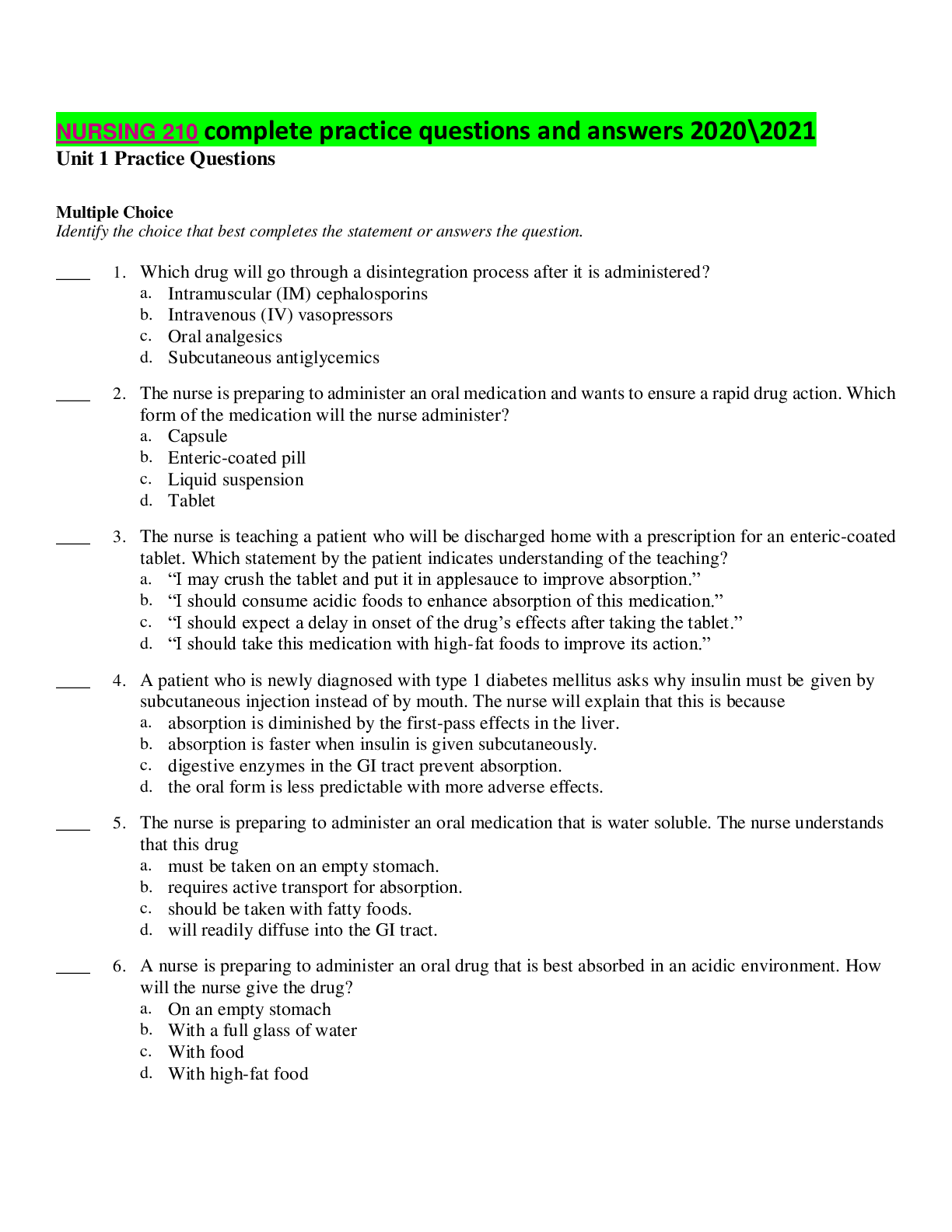
Buy this document to get the full access instantly
Instant Download Access after purchase
Buy NowInstant download
We Accept:

Reviews( 0 )
$13.00
Can't find what you want? Try our AI powered Search
Document information
Connected school, study & course
About the document
Uploaded On
Dec 08, 2020
Number of pages
30
Written in
Additional information
This document has been written for:
Uploaded
Dec 08, 2020
Downloads
0
Views
91

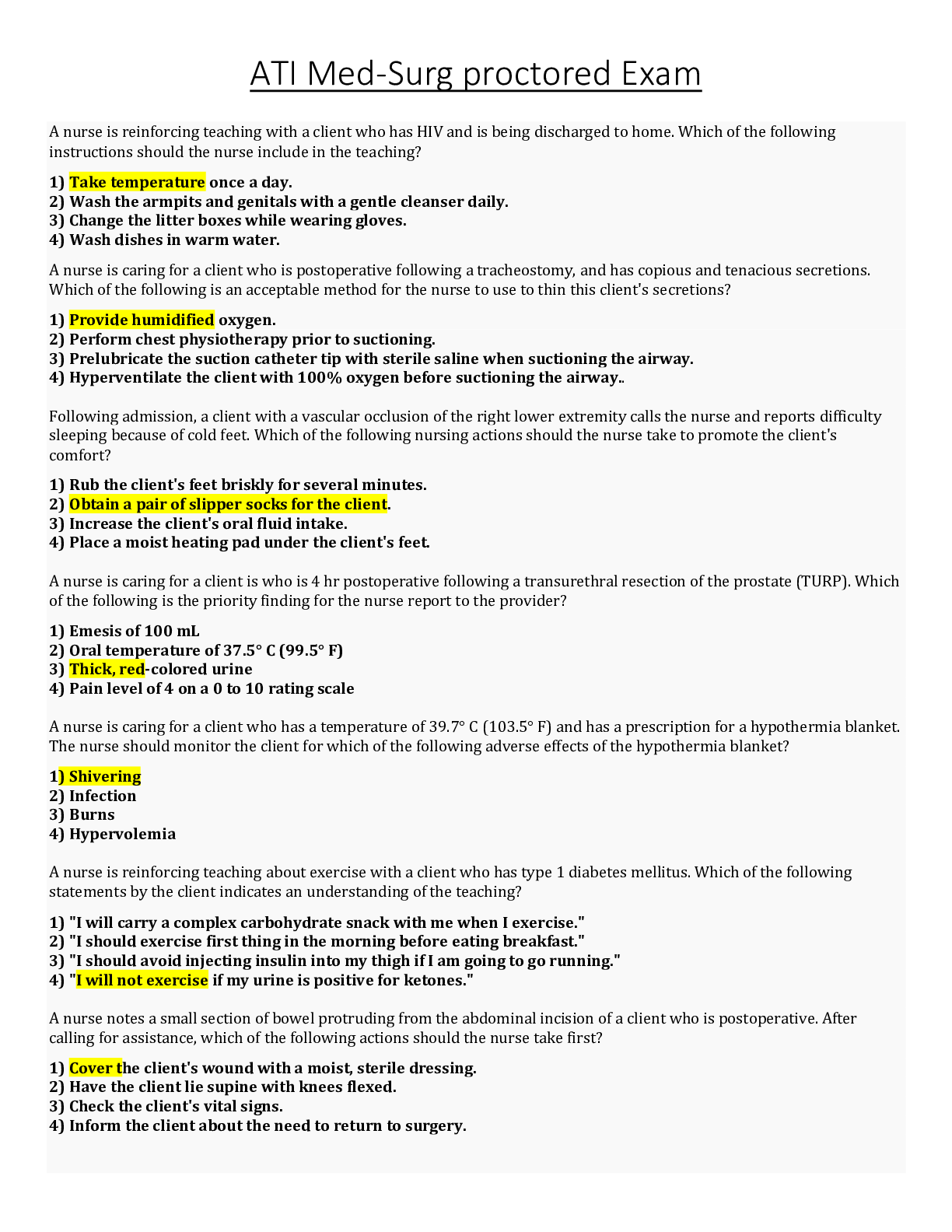

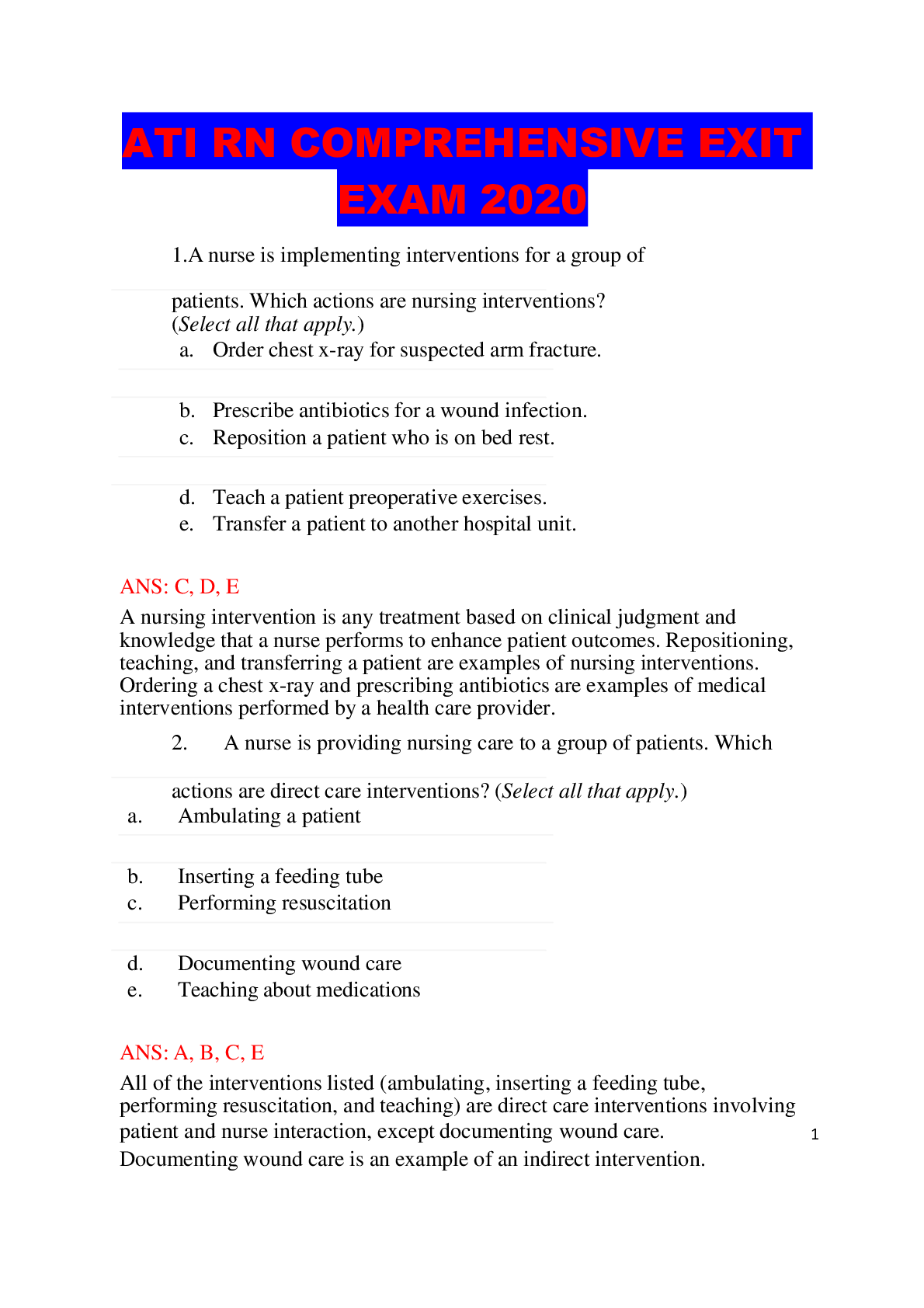
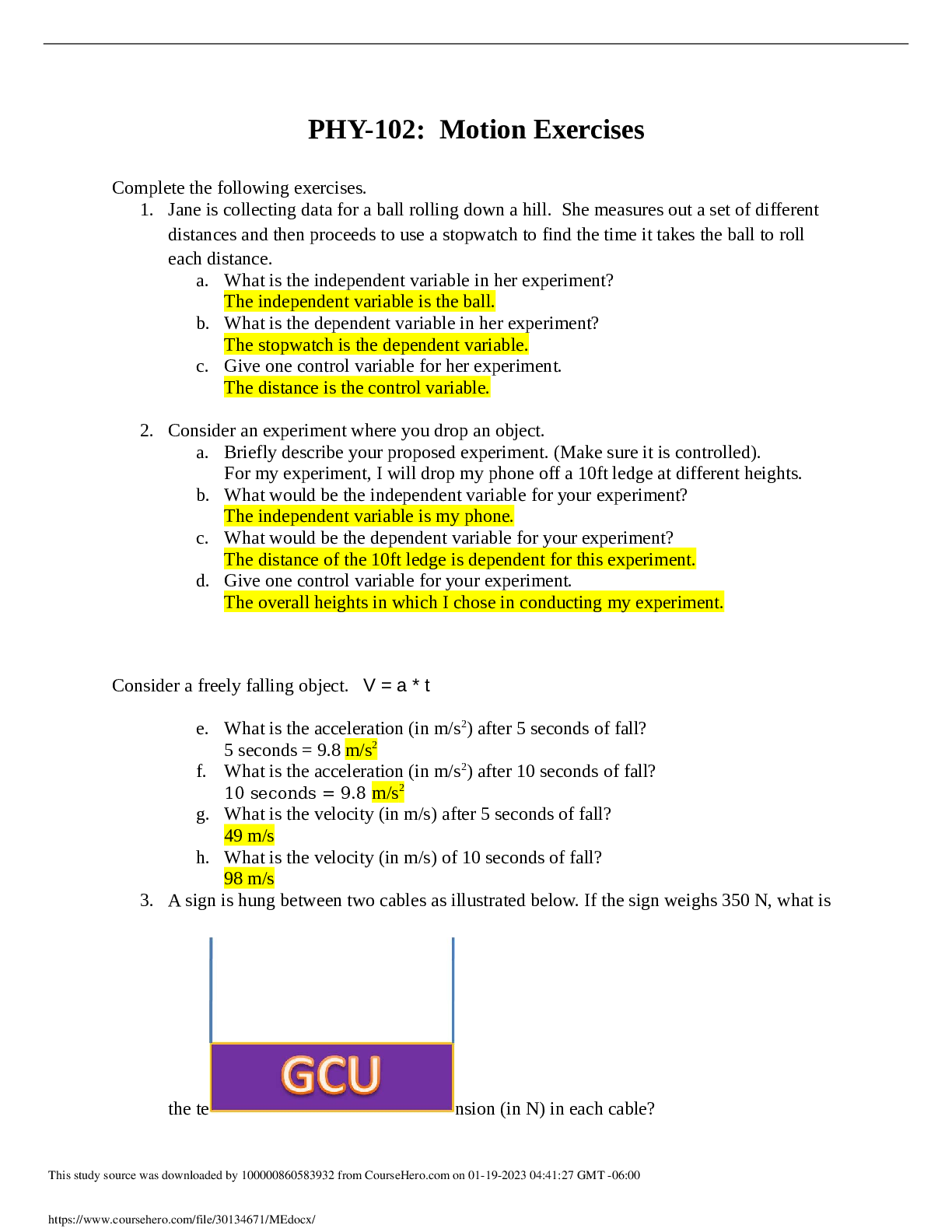
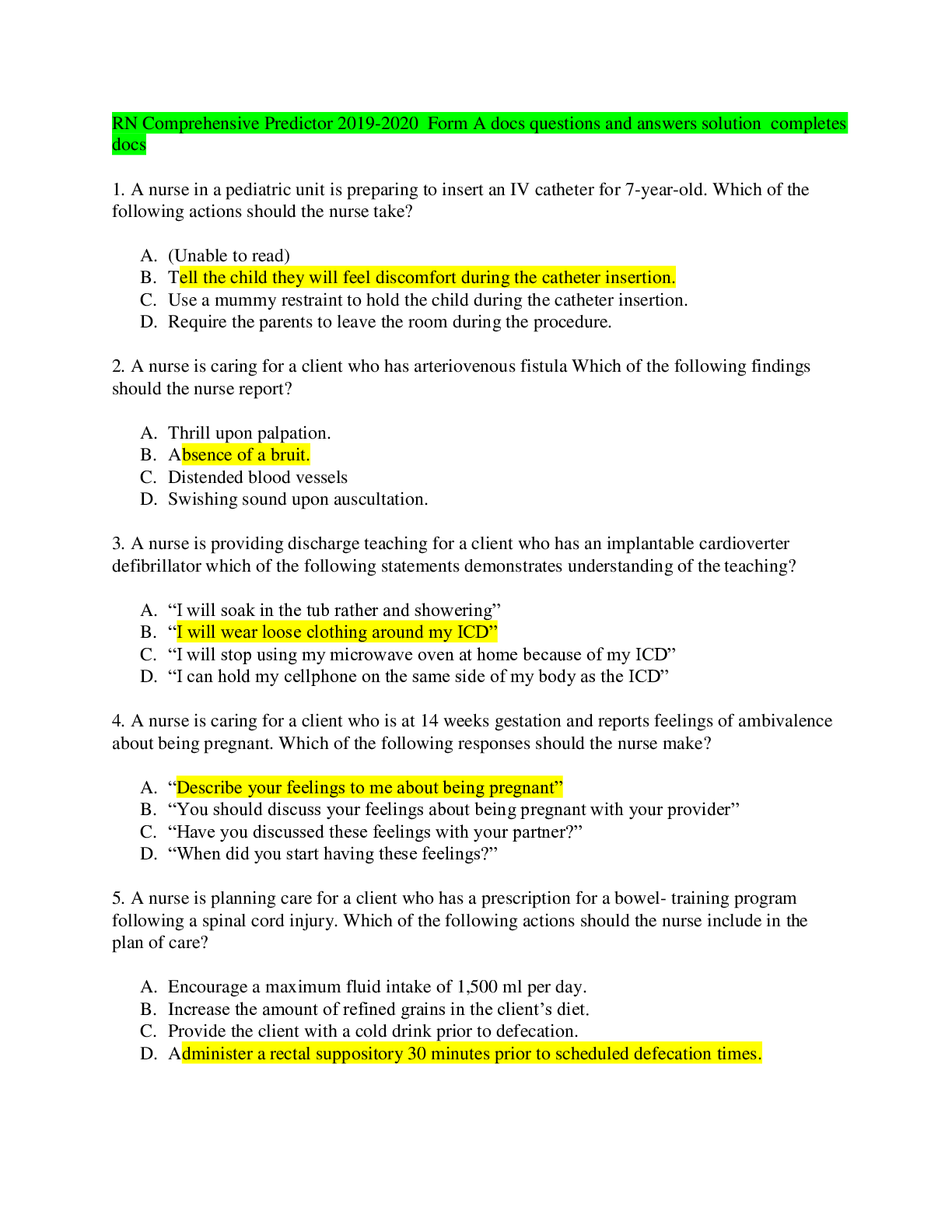


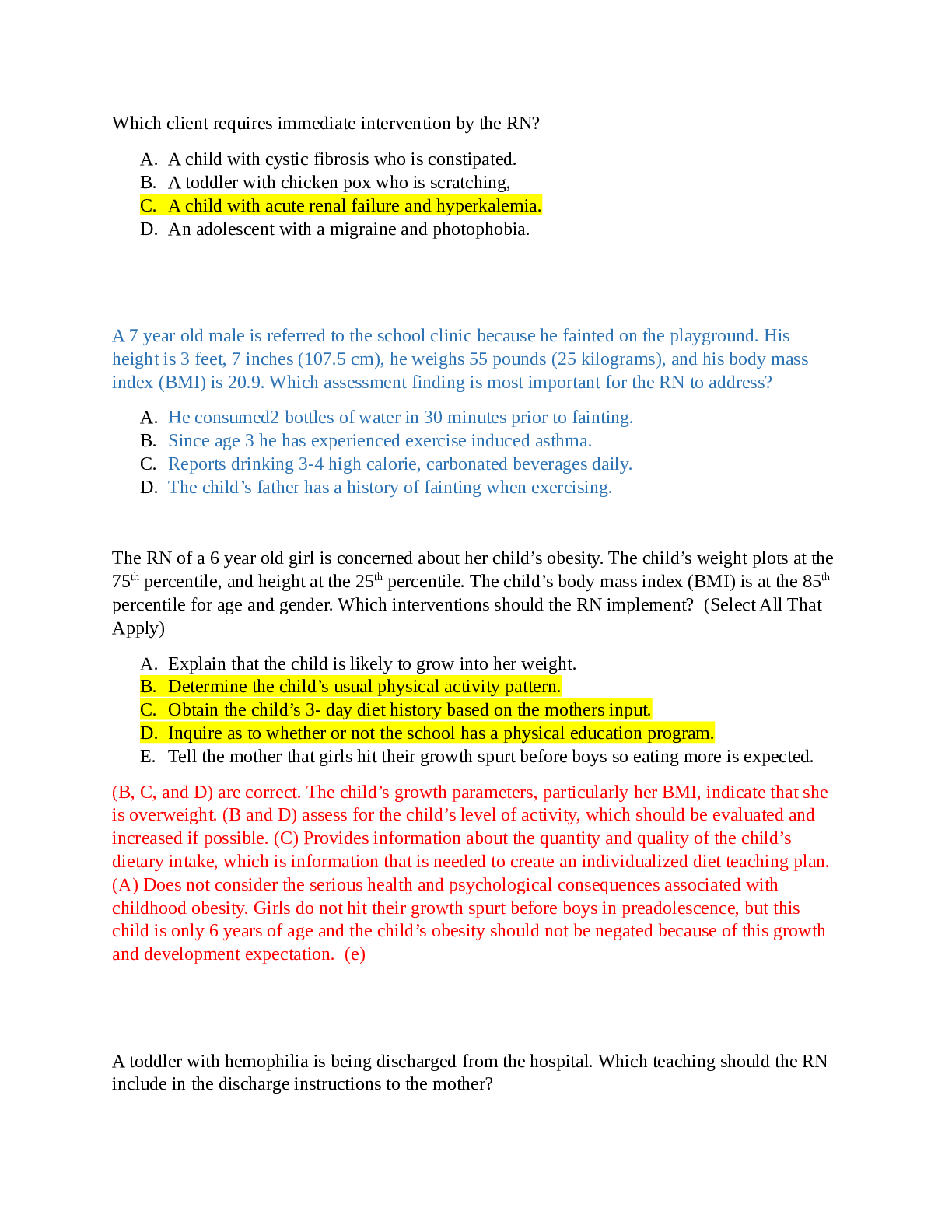



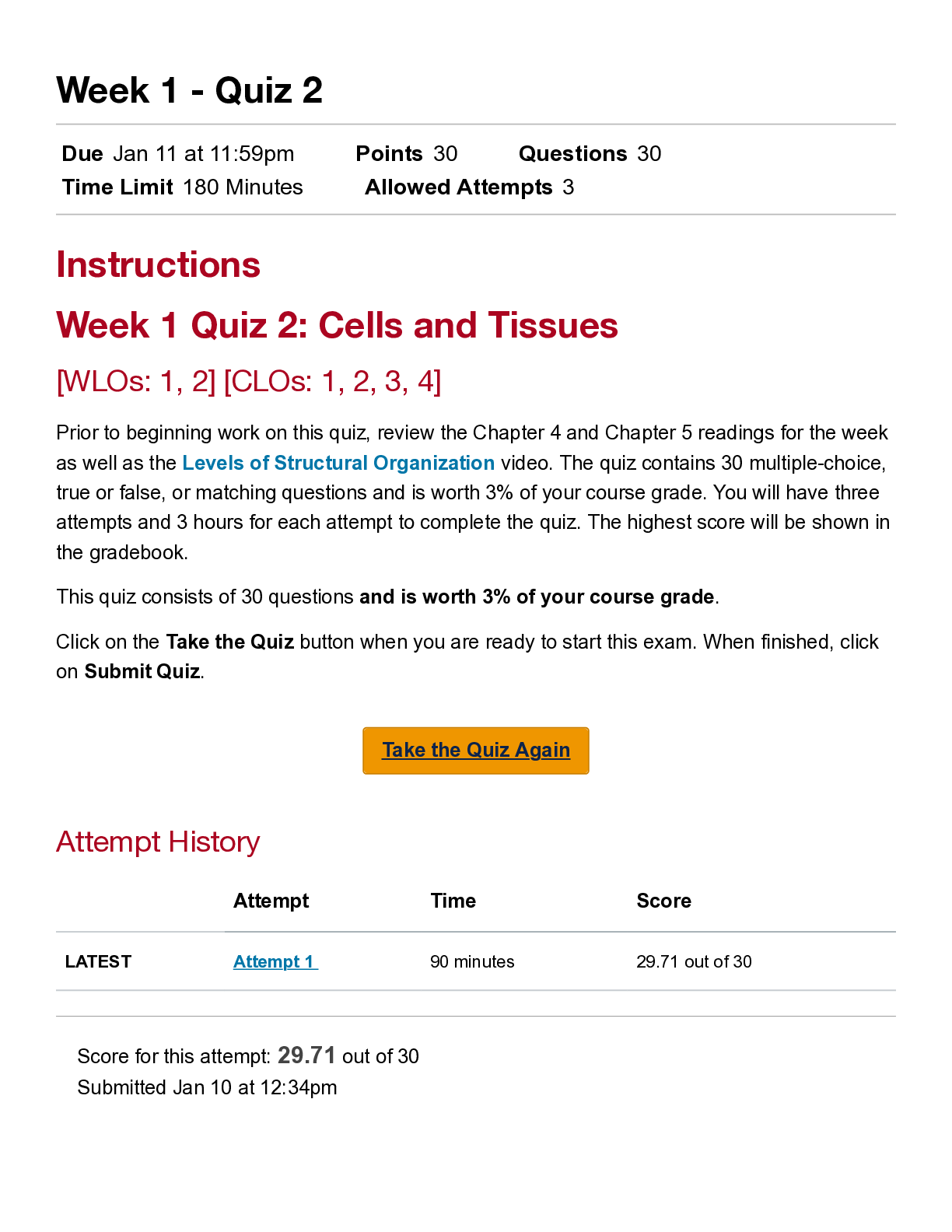


.png)
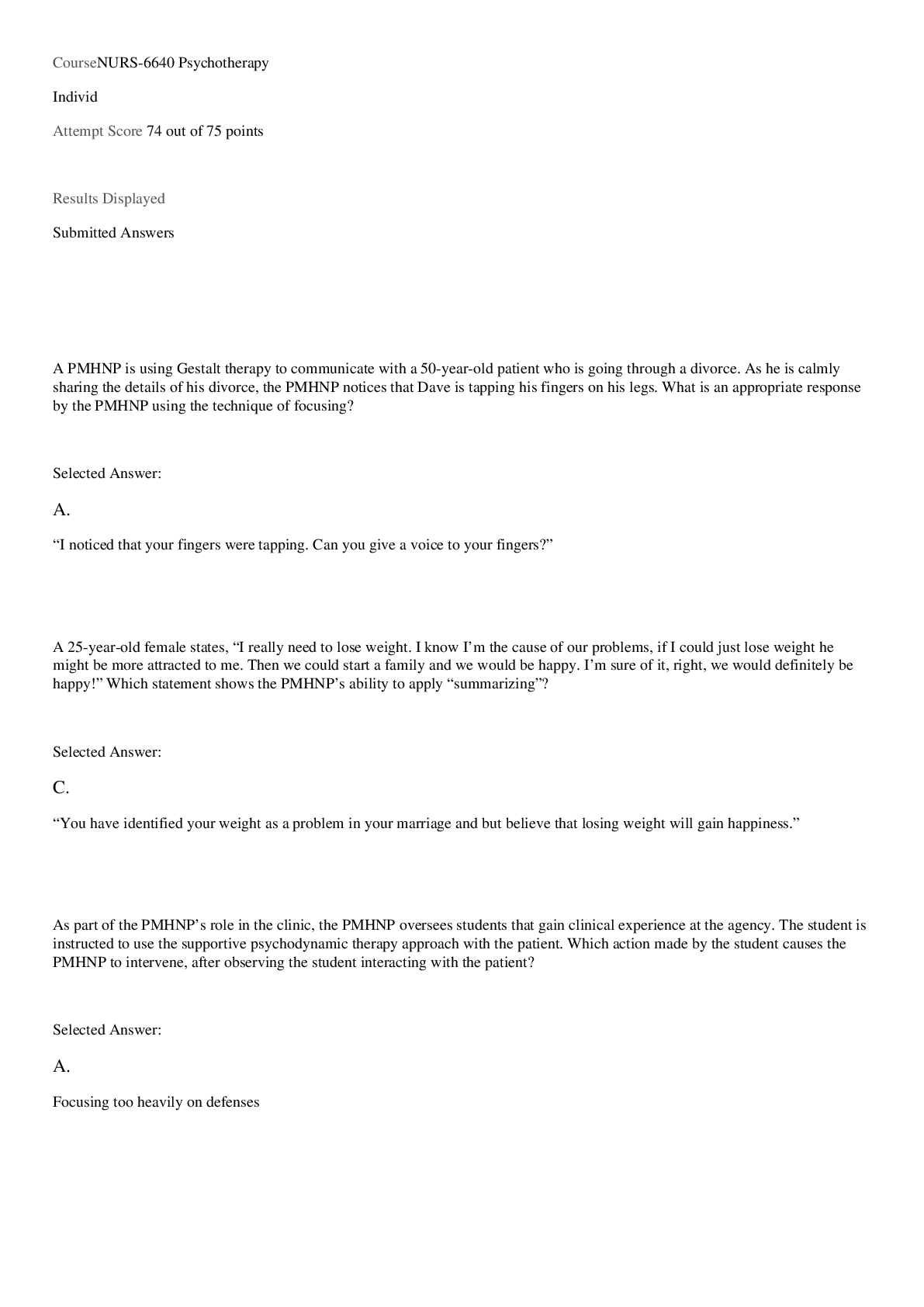

 COMPLETE EXAM COMPLETE PRACTICE QUESTIONS AND ANSWERS A GRADED EXAM.png)

